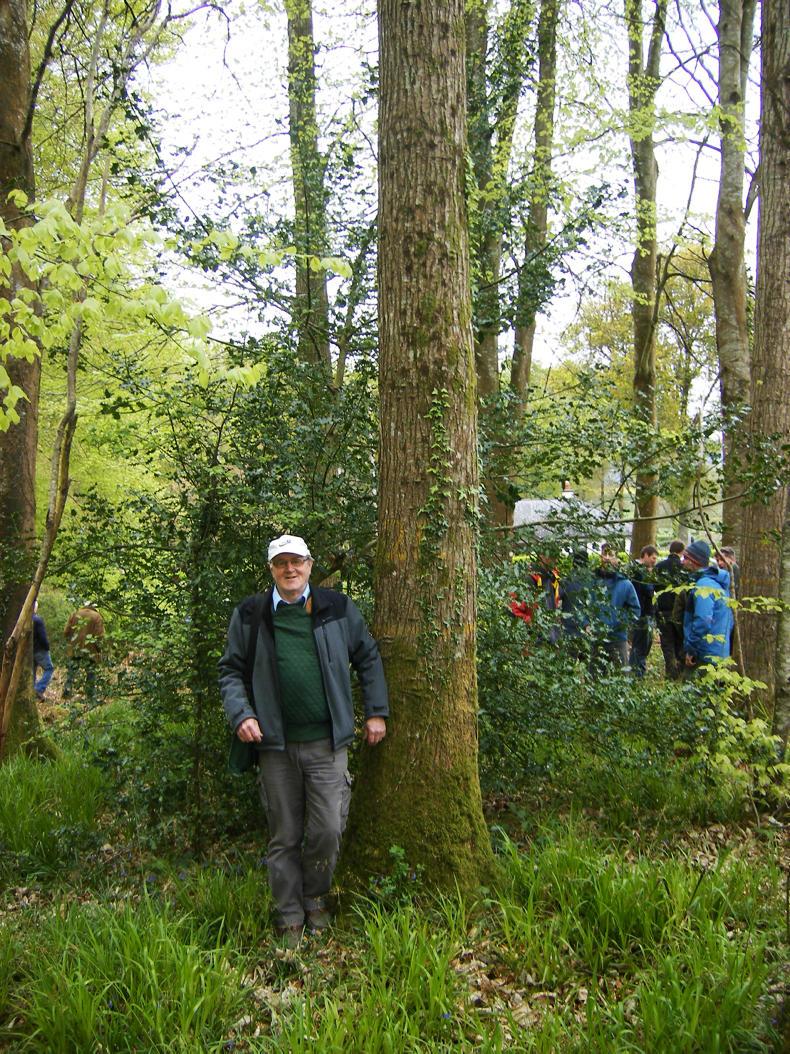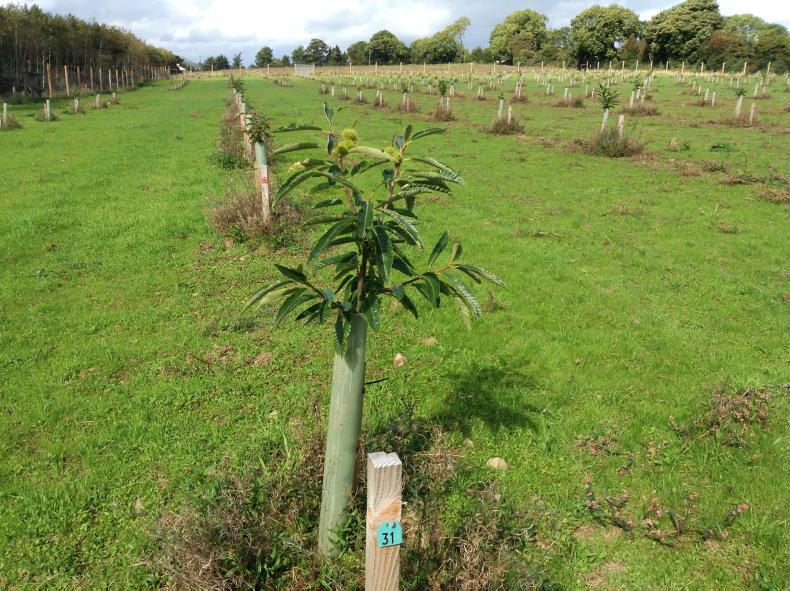Despite adapting well to Irish site and climatic requirements, sweet or Spanish chestnut is rarely planted in Ireland. It forms less than 0.1% of Irish forests, or an area of 460ha.
It is not native to Ireland or Britain but is now regarded as a naturalised species. It was introduced to Britain by the Romans 2,000 years ago. Nobody knows for sure when it was introduced to Ireland, but it was probably well established by the 17th century as it features in Zoilomastix by Don Philip O’Sullivan Beare, which he completed in 1625.
Sweet chestnut is widespread throughout southern Europe but originated in what was once Asia Minor. It received its Latin name, Castanea sativa, from the Turkish city of Kastanaia. The common name varies depending on location as it is known as Spanish, Portuguese and European chestnut. Sweet chestnut is probably the more relevant name today given its wide distribution and its ability to produce crops of edible nuts unlike the horse chestnut which is inedible, even for horses.
Shelter
It grows well in a variety of sites in Ireland, but it is well to avoid exposed or frosty sites. Like most species, it doesn’t like extremes such as very wet and very dry soils. It needs shelter and while it won’t thrive on nutrient-poor soils, it will do well on moderately fertile light soils, although it may need phosphate on “nutritionally marginal sites”, according to the authors of A Guide to Forest Tree Species Selection and Silviculture in Ireland.
It should be planted at 2m x 1.5m spacing or a stocking rate of 3,500 per hectare. It is relatively easy to establish as it grows fast during the first few years and is usually free of vegetation competition by the end of the second growing season. Where vegetation competition is a threat to establishment, sweet chestnut responds well to selective chemical weed control.
Thinning
Planted on the right site, sweet chestnut is wind-firm. Crop should be thinned with a view to selecting between 350 and 400, straight, lightly branched final crop trees. All publications on sweet chestnut advise against the sudden opening up of stands as this can affect crown vigour.
The thinning regime is similar to ash and since ash was removed as a grant-aided species, sweet chestnut may be a good alternative. As it produces high yields over short rotations on suitable sites, it is closer to ash as a timber producer than broadleaves such as oak and beech. We will assess timber qualities and end uses of chestnut next week.
 Ted Horgan (pictured), forestry management consultant, believes that sweet chestnut has an important role to play in Ireland’s broadleaved afforestation programme. “I am all in favour of promoting sweet chestnut and advocating its increased planting but this should be balanced by outlining the importance of correct site choice and aftercare,” he told a group of foresters and forest owners at a field day organised by the Society of Irish Foresters in Co Waterford earlier this year. He produced data for 56 “plus trees” selected from sweet chestnut stands around Ireland with an average age of 53 years. “Plus trees should have desirable characteristics such as straight stem, slight taper, light branching, persistent leader and an absence of spiral grain and forking,” he maintained.
Ted Horgan (pictured), forestry management consultant, believes that sweet chestnut has an important role to play in Ireland’s broadleaved afforestation programme. “I am all in favour of promoting sweet chestnut and advocating its increased planting but this should be balanced by outlining the importance of correct site choice and aftercare,” he told a group of foresters and forest owners at a field day organised by the Society of Irish Foresters in Co Waterford earlier this year. He produced data for 56 “plus trees” selected from sweet chestnut stands around Ireland with an average age of 53 years. “Plus trees should have desirable characteristics such as straight stem, slight taper, light branching, persistent leader and an absence of spiral grain and forking,” he maintained.
“These select trees had an average height of 24.3m, 43.4cm diameter (at 1.3m above the ground) and 10.4m of defect-free bole length,” he said. The results would have been even more impressive, he claimed, “but many trees were unable to achieve their potential due to overstocking”.
The medium- to long-term challenge facing foresters wishing to establish sweet chestnut is sourcing nursery plants. A programme initiated by Future Trees Trust (FTT) is now well under way to produce a viable quantity of sweet chestnut seed. Ted told the attendance “the main objective of the FTT project is to improve the vigour and quality of planting stock of the main broadleaf species used in Britain and Ireland including sweet chestnut”.
Grafting
He said that scion material from 206 plus trees – 53 in Ireland and 150 in England – has been propagated by grafting. “Grafted material from the Irish collection has been archived in a clonal bank at Kilmacurragh, Co Wicklow, while plans are in train to establish an archive of both the Irish and British collections.” This not only safeguards this key genetic resource, but also provides material for the establishment of clonal seed orchards, which originated as plus trees.
Ted outlined the objective of these seed orchards, which is to deliver improved seed to nurseries.
“In 2016, two chestnut orchards were established, one in England, while the first chestnut clonal seed orchard in Ireland was established in the lands of Ellen Parkinson at Kilmacthomas, Co Waterford. By virtue of being grown from grafted stock, this orchard is expected to start producing viable quantities of seed in about 10 years.” In the meantime, private nurseries can provide limited supplies mainly sourced in France and the UK.






 This is a subscriber-only article
This is a subscriber-only article





SHARING OPTIONS: